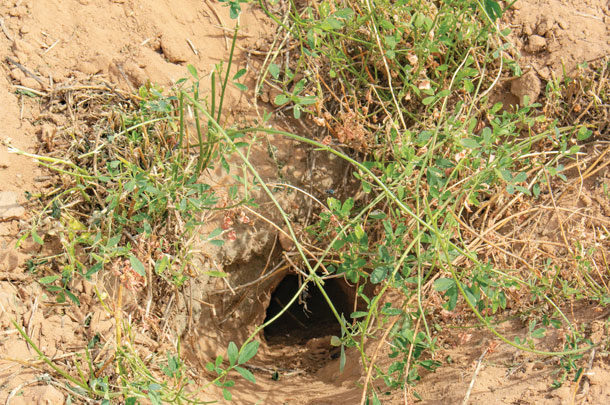Prime causes of dirt in hay are improperly set rakes, pivot irrigation wheel tracks that push soil high enough for the swather and rakes to hit and the abominable gopher.
Why is dirt in hay an issue? First, it isn’t particularly good for the animal being fed the hay. Enough dust or dirt and the finest hay will become unpalatable. That will affect feed intake and consequently production.
Second, excess dust and dirt in hay will skewer the lab analysis. It will show up with a higher-than-normal ash percentage in the test results, and that will alter the accuracy of the NDF (neutral detergent fiber) portion of the test to lower both the RFV (relative feed value) and RFQ (relative feed quality) indexes. That means dirt in your hay will make it test lower than what it really is, which means it will be worth less to the buyer.
Third, exporters avoid dusty, dirty hay like the plague. Dirt is on the forbidden list of what can be in a bale of hay imported into Japan. A bit of dirt found in hay on arrival and a whole shipment will be returned to the country of origin.
And fourth, if it’s gophers causing the dirt, they are also dramatically reducing your tonnage.
A swather that uses a sickle to cut hay will blast through minor dry gopher mounds and some wet ones but will leave lumps, chunks and handfuls of gopher dirt in the hay. Large or wet gopher mounds (as well as wheel track swells) often plug the cutter bar and may not be noticed by the operator. This drags down instead of cutting some of the hay, adding wet slugs to the baled hay.
A rotary swather, which is best described as a row of robust lawnmower blades turning fast enough to cleanly cut hay at speed, reacts differently. Wet or dry, a gopher mound is usually blasted into dust or dirt leaving it finely interspersed with the hay rather than in handfuls or clods and clumps. This can hide a gopher problem until it affects yield and palatability of hay.
Be aware that rotary swathers can mask a gopher infestation. This can delay management of gophers when it’s a small incursion into one side of a field until it’s a farm-wide disaster.
When you take a core sample of hay for analysis, lay the plastic bag containing the sample in your hands. Now roughly rattle and shake the sample for several seconds. Then carefully turn the bag over. If there is significant dirt in the sample, it will now show up on what was the bottom side of the bag while you were rattling it.
If it’s your hay, go back and see if you can find what part of the stack, and conversely the field, the dirt came from. Then try again for a clean sample.
If the sample is from a stack you’re looking to buy, you now know there is a dirt problem somewhere in the stack. Proceed with caution on that purchase.
Check the location and surroundings of the stack. If it’s possible dust has blown into the side of the haystack, try this: Go down the side of the stack, and with your core tool, go into each bale you intend to sample only 6 inches or so. Then empty your core tool and go back to those same holes. Now push the core tool its full length into those holes. The resulting sample will be from deep enough inside the bale to eliminate bale-end surface contamination. Do the shake and rattle test again. If there’s no visible dirt, you have your answer.
Dealing with gophers is like washing your face – gophers will return, and your face needs washed again soon.
Where and how you stack your hay can totally control bottom-bale damage. That is another thing you can control. Hay does best stacked where any weather-sourced moisture will run away from the stack, rather than into or under it.
A base to stack hay on that is 6 to 8 inches (at least) above ground level and made of heavy drain rock will create an air space between the ground and the hay, preventing moisture from subbing up into the bottom bales (think of the rock the railroad uses to lay their railroad ties and tracks on).
Remember that water runs downhill. See that “downhill” is sloping away from the haystack. Keep accumulated snow (especially snowdrifts) cleared away from the stacks. In addition to keeping melting snow from getting under the tarps, it will leave the ground between the stacks drier and more likely to allow hay trucks in, to turn the results of your haying efforts into money.
I have seen 2-year-old stacks that were stacked on an elevated large gravel base, which were side and top tarped, hauled out with the bottom bales as dry and green as the day they were stacked.
You’re not done when it’s in the stack. You’re done when the last bale has been hauled off and the last check has cleared the bank. ![]()
PHOTO: Gopher mounds can add dirt to your hay and drive down feed quality. Photo by Lynn Jaynes.










